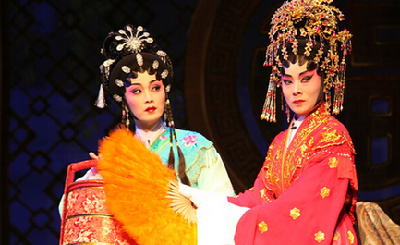

Cantonese Opera Cantonese opera is one of the major Chinese opera categories. It is a traditional Chinese art form that originated in southern China’s Cantonese culture, and involves music, singing, martial arts, acrobatics and acting. Today it is not only very popular in Guangdong, Guangxi, Hong Kong and Macao, but also performed in Southeast Asia, Oceania and American countries where Cantonese people live. Cantonese opera was included in the first list of 518 state-level intangible cultural heritage elements, which was announced on May 20th, 2006.

History Cantonese opera was originally called Narm hei (南戏), or Nanxi (Southern opera) in the Jiajing period of the Ming Dynasty, and was popular in Guangdong and Guangxi at that time. The first performance language was Central Plains music (中原音韵), also known as Theatre Mandarin. Later, at the end of the Qing Dynasty, Theatre Mandarin was changed to Cantonese so that it could be easy for people to understand. During the Qing Dynasty, Nanxi employed “Banghuang” as the basic tone and had also preserved tones of Kunqu opera, Ge opera and Guang opera. By absorbing the folk melodies and tunes of Guangdong, Nanxi was developed into the earliest kind of Cantonese opera.
During the Xinhai Revolution, many patriotic Cantonese performers promoted the idea of fighting with the Qing Dynasty, imperialism and feudalism through their performances in Cantonese opera. They often practiced and organized performances, and meanwhile absorbed the cream of dramas and movies. Soon Cantonese opera had been enriched by the cream of dramas and movies.

Since 1949, when the People’s Republic of China was founded, the Chinese government has placed great importance on the arts. Consequently, Cantonese opera has obtained further development and many excellent operas have been performed. In addition, many new people have been cultivated to engage in this profession. In 1958, the Guangdong Opera House was founded. Dress-up of Cantonese opera Makeup At early stage, performers liked to wear a great deal of makeup, but they used very simple cosmetics. The main five colors—red, black, white, blue and yellow—symbolized loyalty, honesty, cattiness, arrogance and capability, respectively. Different roles might wear different types of make-up in order to match the role. However, in the 1920s performers preferred to wear light makeup, and the most common makeup was “red-white face.”
Headwear There is a variety of headwear used in Cantonese opera, such as headgear, chignon and accessories. Different types of headwear have their own characteristics, so they must each be used and protected in a different way. In general, females have more headwear than males. But male performers do have some headwear, such as Taizi (Chinese prince) helmets. What Jia Baoyu in A Dream of Red Mansions wears is a Taizi helmet, which is often worn by princes or young generals.

Costume In the beginning, Cantonese opera costumes reflected the clothing style of the Ming Dynasty. Later, as Peking opera became increasingly popular, it was strongly influenced by Peking opera costumes. Costumes were made of cloth and later some accessories were added. Today embroidered costumes are the order of the day.
Different roles require different costumes. For example, an actor playing the Xiaosheng, a very gentle role, wears a costume with long sleeves, while the Xiaowu, an acting role, demands a costume with short sleeves so as to act easily.
Performing skills Generally, Cantonese opera performers have to master four skills: singing, acting/movement, delivery of speeches, and martial/gymnastic skills.

Different roles conform to different requirements and are each sung in their own way. Males often sing falsetto to act as females. Until the 20th century, all female roles were performed by males. Acting refers to body language, including gestures and particular styles of walking on the stage. Performers deliver speeches to inform the audience of the opera’s plot and the characters’ emotions.
Musical instruments To date, more than 40 musical instruments have been used in Cantonese opera. They can be divided into four categories: wind instruments, plucked instruments, string instruments and percussion instruments.
Cantonese opera roles Cantonese opera has ten roles: Mo, Sheng, Dan, Jing, Chou, Wai, Xiao, Fu, Tie and Za. In order to perform these roles well, opera performers have to receive extensive training and master skills required by the role.

Cantonese operas Many well-known operas are still performed today, such as The Purple Hairpin (紫钗记) and Rejuvenation of the Red Plum Flower, which originated in the Yuan Dynasty. Other Cantonese operas are adapted from western movies or novels.
Cantonese opera performers There have been many famous Cantonese opera performers. From the 1920s to the 1940s, Xue Juexian, who played Wen and Wu roles, and Ma Shi, who played Chou roles, made great contributions to the development of Cantonese opera. Today, the CYL Cantonese Opera Troupe plays an important role in the development and promotion of Cantonese opera.
Many Cantonese operas preach the importance of being loyal to one’s country, filial to one’s parents, and kind to one’s friends. Therefore, Cantonese opera not only entertains, but also plays a significant part in cultivating good values.

